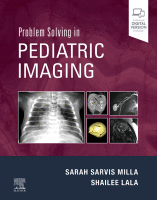Physical Address
304 North Cardinal St.
Dorchester Center, MA 02124

This chapter will review the basics of abusive head and spinal trauma, focus on common questions that arise when interpreting imaging studies of children with inflicted injuries of the central nervous system, and discuss the pros and cons of various…

Encountering a neonatal imaging study may be an unsettling experience to radiologists who do not interpret them routinely. Normal structures often appear different from those of the adult or older child. Moreover, many differential diagnoses and disease processes are unique…

Preterm birth is birth before 37 weeks’ gestational age. The incidence of preterm birth is approximately 1 in 10 births in the United States. The imaging of a preterm infant is not uncommon, and especially in the neonatal period, the…

Whether the history is motor vehicle accident, fall from monkey bars, or sports-related injury, musculoskeletal trauma is one of the most common reasons for emergency department visits. Knowledge of the developing bone anatomy and specific pediatric fractures leads to appropriate…

Why Imaging? Pediatric patients with soft tissue musculoskeletal masses encompass a wide array of pathology that ranges from benign fatty masses and self-involuting vascular tumors all the way to aggressive malignant lesions that require a multidisciplinary approach and staging before…

Vascular malformations arise from disorganized angiogenesis and manifest as congenital abnormalities that may be isolated events or associated with syndromes. The International Society for the Study of Vascular Anomalies (ISSVA) recognizes vascular malformations as a separate entity from vascular tumors…

“Knowledge is power…knowledge is safety…knowledge is happiness.” —Thomas Jefferson Bone lesions are a frequently encountered diagnostic challenge faced by radiologists in the evaluation of pediatric and adolescent patients. Up to 42% of all bone lesions are detected in the first…

The elbow is complex in its multiple articulations, which allow for flexion and extension, as well as supination and pronation. Imaging of the pediatric elbow is deceptively simple: two conventional radiographic orthogonal views are all that is required to diagnose…

The pediatric foot can be complex, from both clinical and imaging perspectives. Acquired and congenital diseases can affect the foot, especially during early childhood development. Because radiographs are often first line in imaging, having an appreciation for the normal appearance…

Skeletal dysplasias are bone and cartilage disorders that result in abnormal skeletal development and often, short stature. Skeletal dysplasias and syndromes with bony involvement are not uncommonly seen in pediatric populations. The differential diagnosis of dysplasias includes more than 450…